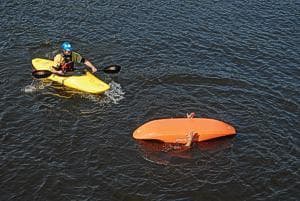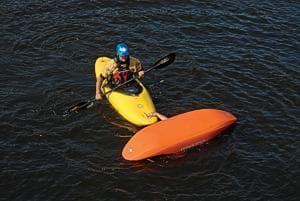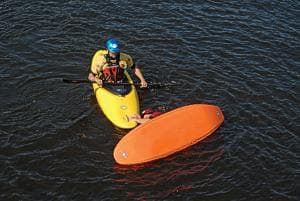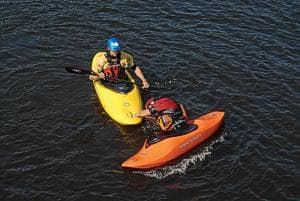Group Rescues: The T-Rescue
The T-rescue involves a rescuer offering one end of his kayak to an upside-down paddler to use for support as she hip-snaps her boat upright. The T-rescue is the most basic form of kayak rescue and will only really come into play when there is a special teacher/student relationship between the two paddlers. Otherwise, it's unreasonable for any kayaker to expect to receive a T-rescue when out on the river. It's also crucial that the one getting rescued has practised and become comfortable with the skill of hip snapping, which we've looked at in depth in the "Rolling" segment of this book.




The T-rescue starts with the "victim" upside down and the rescuer close by. Because the victim knows the rescuer is there to provide a T-rescue, the victim calmly tucks his body forward while upside down to protect his face and body. He then reaches up to the surface with both hands, one on each side of his kayak. The first thing he should do is slap the bottom of his boat three times to let the rescuer know he needs help.
He will then proceed to run his arms alongside the kayak to create as large a target area as possible for the rescuer. The rescuer will then approach the victim at ninety degrees and offer her bow for support. This usually means running lightly into the side of the upside-down kayak in the area that the arms are sweeping. The victim's arm will soon bump into the rescuer's kayak and then he grabs that end with both hands. On occasion, the rescuer is dead on target and the victim gets a little jolt of pain from the impact on his hand, but in the big picture, we can't worry too much about this!
The success of the T-rescue now revolves around the victim's ability to hip snap the kayak upright. Hip snapping refers to the action of rotating the hips to right the kayak. Without a good hip snap the victim will naturally try to push his head and body back over his kayak, which won't do anything but sink the rescuer's bow and maybe even scare the rescuer off! Once upright, the rescuer can help recover the lost paddle, and then both can continue to head downstream.
On top of being a rescue reserved for situations where there is a special student/instructor relationship and the clear understanding that the rescuer will be looking to provide a T-rescue, it is of course very important that the T-rescue be practised and used in deep, safe whitewater in which a paddler isn't subjecting himself to further danger by hanging out upside down. If in doubt, get out!
Ken is a World Champion Kayaker and the author and producer of an award winning series of instructional kayaking books and videos. He was recognized by "Paddler Magazine" as one of their 'Paddlers of the Century'. For more information, visit www.helipress.com.
Related Articles
Even though they are flipping over, missing their gates and failing their maneuvers, they still look…
Last month we discussed how to detect and patch (not "repair") a leak on a typical roto-molded kayak…
A kayaker should have a number of recovery methods to choose from in their bag of skills. I feel the…
It is always good to have a few different ways to perform a capsize recovery. The main solo recovery…

